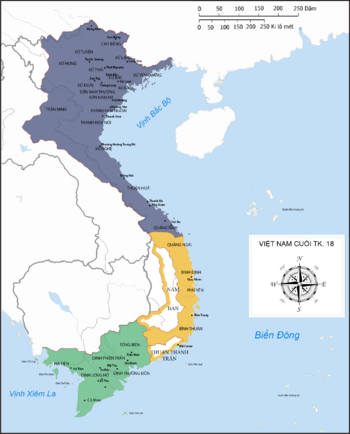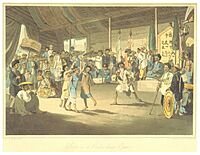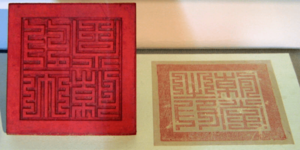Tây Sơn dynasty facts for kids
Quick facts for kids
Đại Việt Quốc
大越國
Đại Việt Quốc |
|||||||||||||
|---|---|---|---|---|---|---|---|---|---|---|---|---|---|
| 1778–1802 | |||||||||||||

Political division of Vietnam at the end of the 18th century: Territory controlled by Nguyễn Huệ Territory controlled by Nguyễn Nhạc Territory controlled by Nguyễn Lữ, later captured by Nguyễn Ánh in 1789
|
|||||||||||||
| Status | Duchy within Lê dynasty of Đại Việt (1778–1788) Internal imperial system within Qing tributary (1789–1802) |
||||||||||||
| Capital | Đồ Bàn (1776–1788) Phú Xuân (1788–1801) Bắc Thành (1801–1802) |
||||||||||||
| Common languages | Vietnamese Written Chữ Nôm script (official) |
||||||||||||
| Religion | Buddhism, Taoism, Catholicism, Islam | ||||||||||||
| Government | Rebellion (1771–1778)
Duchy of Lê dynasty (1778–1788) Absolute monarchy (1788–1802) Rump state(1801-1802) |
||||||||||||
| Emperor | |||||||||||||
|
• 1778–88
|
Thái Đức as (Emperor) |
||||||||||||
|
• 1788–92
|
Quang Trung as (Emperor) |
||||||||||||
|
• 1792–1802
|
Nguyễn Quang Toản | ||||||||||||
| Legislature | None (rule by decree) | ||||||||||||
| History | |||||||||||||
|
• Nguyễn Nhạc establishes dynasty
|
1778 | ||||||||||||
|
• Lê dynasty collapsed
|
3 February 1789 | ||||||||||||
|
• Nguyễn Ánh captures Đông Kinh
|
18 June 1802 | ||||||||||||
| Population | |||||||||||||
|
• 1800
|
unknown, circa 10 million | ||||||||||||
| Currency | Copper-alloy and zinc cash coins | ||||||||||||
|
|||||||||||||
| Today part of | Vietnam China Laos Cambodia |
||||||||||||
| Nguyễn Tây Sơn |
|||
|---|---|---|---|
| Country: | Kingdom of Đại Việt (Vietnam) | ||
| Titles: |
|
||
| Founder: | Nguyễn Nhạc | ||
| Final Ruler: | Nguyễn Quang Toản | ||
| Founding Year: | 18th century | ||
The Tây Sơn dynasty was a powerful ruling family in Vietnam. It was started by three brothers from a village called Tây Sơn. These brothers, Nguyễn Nhạc, Nguyễn Huệ, and Nguyễn Lữ, led a big rebellion. They fought against the Lê dynasty and two other powerful families, the Nguyễn lords and the Trịnh lords.
The Tây Sơn dynasty brought an end to a long war between the Trịnh and Nguyễn families. They also ended the Lê dynasty and united Vietnam for the first time in 200 years. The most famous of the brothers was Quang Trung, who became an emperor. Under his rule, Vietnam had a time of peace and growth. However, after he died, his son was not as strong a ruler. This allowed Nguyễn Ánh, a leader from the old Nguyễn family, to take back control of the country. Nguyễn Ánh then started his own ruling family, the Nguyễn dynasty.
Contents
What Does "Tây Sơn" Mean?
The Tây Sơn dynasty got its name from the Tây Sơn district in Bình Định province. This was the home of the three brothers who founded the dynasty. The name "Tây Sơn" means "western mountains." It comes from the Chinese words Xīshān, where Xī means west and shān means mountain.
The Story of the Tây Sơn Dynasty
How the Rebellion Started
In the 1700s, Vietnam was officially ruled by the Lê dynasty. But the real power was held by two warring families. The Trịnh lords ruled the north from Thăng Long. The Nguyễn lords ruled the south from their capital, Huế. These two families fought many wars for control of Vietnam.
Life was very hard for ordinary people. Most of the land was owned by a few rich landlords. The government officials were often corrupt and unfair. They even sold important exam degrees to rich people. While the ruling lords lived in fancy palaces, the people became poorer. The Nguyễn lords also fought many wars against Cambodia and Thailand. Even though they often won, these wars cost a lot of money and lives.
The Tây Sơn Brothers Rise Up
In 1771, three brothers—Nguyễn Nhạc, Nguyễn Huệ, and Nguyễn Lữ—started a revolt. They were not related to the Nguyễn lords. They lived in the village of Tây Sơn in central Vietnam. They rebelled because of high taxes and corruption.
The Tây Sơn brothers said they wanted to help the common people. They promised to end unfair rule, unite the country, and bring back the power of the Lê emperor. They also said they would remove corrupt officials and give land back to the poor. Many poor farmers and local tribes joined their cause.
In 1773, the Tây Sơn captured the port of Qui Nhơn. Merchants there, who had suffered under unfair laws, also supported the uprising. The Nguyễn lords finally realized how serious the revolt was. They made peace with the Siamese (Thai) king.
However, their problems grew when Trịnh Sâm attacked their capital, Phú Xuân (modern-day Huế). The Trịnh army captured the city. The Nguyễn lords had to escape to Gia Định (now Saigon).
The Trịnh army kept moving south. The Tây Sơn army also continued conquering southern cities. The Nguyễn lords were attacked from too many sides. In 1776, the Tây Sơn army captured Gia Định. Most of the Nguyễn family was killed, but one nephew, Nguyễn Ánh, escaped to Siam. In 1778, the oldest Tây Sơn brother, Nguyễn Nhạc, declared himself Emperor.
Fighting Against Siam
For the next ten years, the Tây Sơn worked to control the lands that used to belong to the Nguyễn. Nguyễn Ánh was a tough enemy. He convinced the King of Siam, Taksin, to invade Vietnam to help him. The Siamese army attacked in 1780. But after several years of fighting, they could not defeat the Tây Sơn.
In 1785, Siam launched another invasion. They took over part of the Mekong Delta. But Nguyễn Huệ defeated them in a major battle called the Battle of Rạch Gầm-Xoài Mút.
Conquering the Trịnh Lords
After defeating the Nguyễn for a while, Nguyễn Huệ decided to destroy the power of the Trịnh lords. In 1786, he led a large army north. After a quick fight, he defeated the Trịnh army. The Trịnh lords were not popular, and the Tây Sơn army seemed unbeatable. The Trịnh lord fled north into China. Nguyễn Huệ later married Princess Lê Ngọc Hân, the daughter of the Lê Emperor.
The Fall of the Lê Dynasty and Relations with China
A few months later, Emperor Lê Chiêu Thống realized he had lost all power. He fled north to the Qing dynasty in China. He asked the Qianlong Emperor for help. The Qianlong Emperor agreed to help Lê Chiêu Thống get his power back. In 1788, a large Qing army marched into Vietnam and captured the capital, Thăng Long.
Nguyễn Huệ gathered a new army to fight the Qing. He told his soldiers:
The Qing have invaded our country and occupied the capital city, Thăng Long. In our history, the Trưng Sisters fought against the Han, Đinh Tiên Hoàng against the Song, Trần Hưng Đạo against the Mongol Yuan, and Lê Lợi against the Ming. These heroes did not resign themselves to standing by and seeing the invaders plunder our country; they inspired the people to fight for a just cause and drive out the aggressors... The Qing, forgetting what happened to the Song, Yuan and Ming, have invaded our country. We are going to drive them out of our territory.
Nguyễn Huệ's army launched a surprise attack while the Qing army was celebrating the Lunar New Year. They defeated the Qing at the Battle of Ngọc Hồi-Đống Đa. The Qing army and Lê Chiêu Thống were forced to retreat.
After the battle, Nguyễn Huệ wanted to make peace with the Qing Emperor. He sent a respectful request to the Qianlong Emperor. He wanted to prevent China and Siam from attacking Vietnam together. In 1789, the Qianlong Emperor agreed to recognize Nguyễn Huệ as the official ruler of Vietnam. He gave Nguyễn Huệ the title An Nam quốc vương ("King of Annam"). This meant that Lê Chiêu Thống was no longer supported by China.
The Fall of the Tây Sơn Dynasty
Emperor Quang Trung (Nguyễn Huệ) wanted to get revenge on the Nguyễn lords. He trained his army and built large warships. However, he died suddenly in 1792. His attack plans never happened.
After Quang Trung's death, his son Nguyễn Quang Toản became Emperor Cảnh Thịnh at only ten years old. His uncle, Bui Dac Tuyen, held the real power. He removed many people who had served Quang Trung. This made the Tây Sơn weaker.
This weakness allowed Nguyễn Ánh to take back control of Vietnam. He had help from French military adventurers. In 1800, Nguyễn Ánh captured the Quy Nhơn citadel. In 1801, he took Phú Xuân, forcing Nguyễn Quang Toản to flee. In 1802, Nguyễn Ánh surrounded Thăng Long. The 20-year-old Nguyễn Quang Toản escaped but was later captured and executed. This ended the Tây Sơn dynasty after 24 years. The Nguyễn dynasty then took over Vietnam in 1802.
See also
- Tây Sơn military tactics and organization
- Ten Great Campaigns





